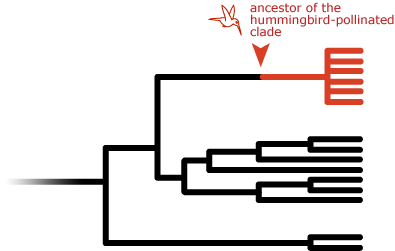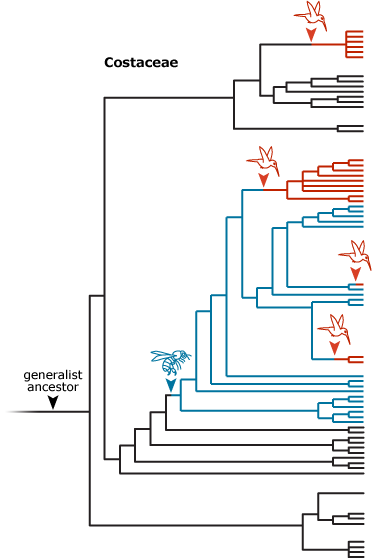Because she knew of other plant groups with convergent pollination syndromes and because she had noticed that some Costaceae with similar flowers weren’t very similar in other ways, for examples in fruit type or leaf shape, Chelsea hypothesized that the same pollination syndrome had evolved multiple times in the Costaceae. To investigate this hypothesis she collected information on the pollination habits of different Costaceae species and mapped that information onto the phylogeny she had built. The plants fell into one of three pollination syndromes: hummingbird-oriented (red tubular flowers), bee-oriented (landing platform with UV nectar guide), and generalist (open flowers that attract many different types of pollinator).
Mapping this information onto the phylogeny allowed her to figure out where on the phylogeny different pollination syndromes evolved. For example, a group of six closely related species (shown in red below) all produce hummingbird-oriented flowers, while their closest relatives (shown in black below) produce generalist flowers. The most likely reason for this pattern is based on the principle of parsimony — which says that the simplest scientific explanation that fits the evidence is the best one. In this case, the simplest explanation for the pattern is that hummingbird pollination evolved once in the ancestor of the hummingbird-oriented clade (marked with a red arrow below) and that all the modern species shown in red below simply inherited the pollination syndrome from that ancestor. The more complicated explanation, which is rejected by the principle of parsimony, is that each of those species individually evolved hummingbird pollination in six separate events.
Chelsea used this method to study pollination syndrome evolution in all the Costaceae. The resulting tree is shown below. It suggests that the ancestor of the Costaceae was a generalist, that bee pollination evolved just once (blue arrow), and that bird pollination evolved four separate times (red arrows)! These results supported Chelsea’s initial hypothesis: the same pollination syndrome (hummingbird pollination) evolved multiple times in the Costaceae. In contrast, she also discovered that bee pollination had evolved just once.
Read more about using phylogenies to understand the evolutionary history of a group, or dig deeper to find out how it's not just the plants undergoing convergent evolution.
Get tips for using research profiles, like this one, with your students.


